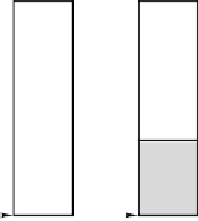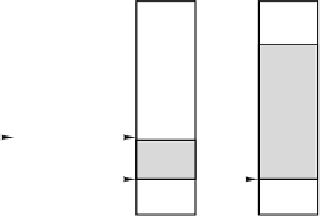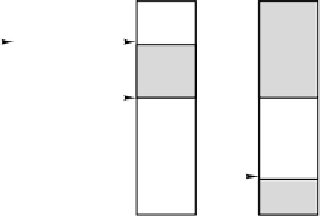Hardware Reference
In-Depth Information
Consider a situation consisting of two independent processes, process 1 and
process 2, which communicate via a shared buffer in main memory. For simplicity
we will call process 1 the
producer
and process 2 the
consumer
. The producer
computes prime numbers and puts them into the buffer one at a time. The consu-
mer removes them from the buffer one at a time and prints them.
These two processes run in parallel at different rates. If the producer discovers
that the buffer is full, it goes to sleep; that is, it temporarily suspends its operation
awaiting a signal from the consumer. Later, when the consumer has removed a
number from the buffer, it sends a signal to the producer to wake it up—that is,
restart it. Similarly, if the consumer discovers that the buffer is empty, it goes to
sleep. When the producer has put a number into the empty buffer, it wakes up the
sleeping consumer.
In
In
Out
Out
In
In
In
Out
Out
In,
out
Out
(a)
(b)
(c)
(d)
(e)
(f)
Figure 6-25.
Use of a circular buffer.
In this example we will use a circular buffer for interprocess communication.
The pointers
in
and
out
will be used as follows:
in
points to the next free word
(where the producer will put the next prime) and
out
points to the next number to
be removed by the consumer. When
in
out
, the buffer is empty, as shown in
Fig. 6-25(a). After the producer has generated some primes, the situation is as
shown in Fig. 6-25(b). Fig. 6-25(c) illustrates the buffer after the consumer has re-
moved some of these primes for printing. Figure 6-25(d)-(f) depict the effect of
continued buffer activity. The top of the buffer is logically contiguous with the
bottom; that is, the buffer wraps around. When there has been a sudden burst of
input and
in
has wrapped around and is only one word behind
out
(e.g.,
in
=
=
52,
and
out
53), the buffer is full. The last word is not used; if it were, there would
be no way to tell whether
in
=
out
meant a full buffer or an empty one.
Figure 6-26 shows a simple way to implement the producer-consumer problem
in Java. This solution uses three classes,
m
,
producer
, and
consumer
. The
m
(main) class contains some constant definitions, the buffer pointers
in
and
out
, and
the buffer itself, which in this example holds 100 primes, going from
buffer
[0] to
buffer
[99]. The
producer
and
consumer
classes do the actual work.
=














